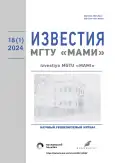On the issue of contactless alternators on movable objects
- Authors: Ryabykh E.A.1, Maleev R.A.1, Akimov A.V.1
-
Affiliations:
- Moscow Polytechnic University
- Issue: Vol 18, No 1 (2024)
- Pages: 53-62
- Section: Electrotechnical facilities and systems
- URL: https://journals.rcsi.science/2074-0530/article/view/256846
- DOI: https://doi.org/10.17816/2074-0530-625880
- ID: 256846
Cite item
Abstract
BACKGROUND: This article discusses automotive inductor alternators of domestic and foreign production with different power and design. A comparative analysis of inductor alternators according to the main electromagnetic parameters and design is carried out. Based on the results of the comparative analysis, conclusions are drawn about the competitiveness of domestic inductor alternators and their superiority over foreign analogues.
AIM: Research and comparative analysis of tractor inductor alternators in order to determine the optimal design, as well as the main characteristics and parameters.
METHODS: The calculation of the magnetic circuit and the idling characteristic is based on the method of successive approximations using iterations. A well-known method with the Blondel diagram is used to calculate the current-speed curve.
RESULTS: A review and comparative analysis of automotive inductor alternators of domestic and foreign production, with various magnetic systems and design, is carried out. The advantages and disadvantages of the magnetic circuit of inductor alternators of both domestic and foreign production are determined and given in comparative tables and current-speed curves. The optimal design of the inductor alternator with the most effective technical and economic indicators was chosen to perform the calculation.
CONCLUSIONS: The calculation of the magnetic circuit and idling characteristics of the 11.3701 three-phase single-pole, single-pack inductor generator with a classical toothed zone and a two-half-period rectifier is carried out. The calculation of the current-velocity curve was performed using the well-known method with the Blondel diagram and the method of successive approximations using iterations.
Full Text
##article.viewOnOriginalSite##About the authors
Evgeniy A. Ryabykh
Moscow Polytechnic University
Author for correspondence.
Email: fczl98@bk.ru
ORCID iD: 0000-0001-7112-1019
SPIN-code: 4843-6000
Postgraduate of the Electrical Equipment and Industrial Electronics Department
Russian Federation, 38 Bolshaya Semenovskaya street, 107023 MoscowRuslan A. Maleev
Moscow Polytechnic University
Email: 19rusmal@gmail.com
ORCID iD: 0000-0003-3430-6406
SPIN-code: 7801-3294
Associate Professor, Cand. Sci. (Engineering), Professor of the Electrical Equipment and Industrial Electronics Department
Russian Federation, 38 Bolshaya Semenovskaya street, 107023 MoscowAndrey V. Akimov
Moscow Polytechnic University
Email: a.akimov5@mail.ru
ORCID iD: 0009-0002-6010-8817
SPIN-code: 8238-8598
Associate Professor, Cand. Sci. (Engineering), Associate Professor of the Electrical Equipment and Industrial Electronics Department
Russian Federation, 38 Bolshaya Semenovskaya street, 107023 MoscowReferences
- Ryabykh EA, Maleev RA, Akimov AV. Switched inductor generators for special purpose vehicles. Izvestiya MGTU «MAMI». 2023;17(3):287–294. EDN: GXYPIB doi: 10.17816/2074-0530-340855
- Akimov SV, Chizhkov YuP. Electrical equipment of cars. Moscow: Za rulem; 2001.
- Akimov SV, Kopylova LV. Calculation of output characteristics of automotive and tractor inductor generators. Мoscow: MAMI; 1987.
- Chernov AE, Akimov AV. Comparative analysis of the energy capabilities of excitation systems for tractor generators. Tractors and Agricultural Machinery. 2017;84(1):46–53. doi: 10.17816/0321-4443-66274
- Chernov AE, Akimov AV. Automated test bench for the study of automobile and bus generator sets. Izvestiya MGTU «MAMI». 2014. Т. 1, №2. C. 5–12. EDN: SXGXIL
- Fesenko MN, Kopylova LV, Korotkov VI. Theory, design and calculation of automotive electrical equipment. Moscow: Mashinostroenie; 1992.
Supplementary files















